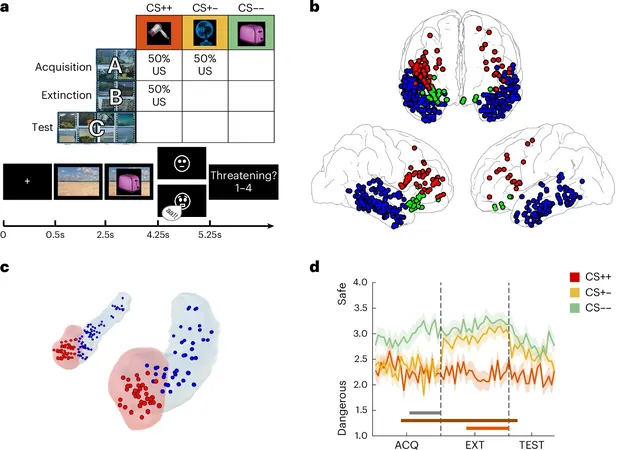
Unlocking the Secrets of Fear: How Our Brains Adapt to Traumatic Memories
2025-08-24
Author: Wei Ling
Understanding Fear Responses
Throughout life, humans can develop intense fear responses to certain stimuli, whether they're animals, objects, or situations, often triggered by traumatic experiences. A deeper understanding of how our brains extinguish learned fears could pave the way for groundbreaking therapies to tackle phobias and anxiety disorders.
Revealing Neural Mechanisms of Extinction Learning
A team of researchers from prestigious institutions, including Ruhr University Bochum and the Paris Brain Institute, embarked on a fascinating study to explore how both humans and animals learn to suppress these fearful memories. Their findings, published in *Nature Human Behavior*, highlight the significant role of stable, context-specific neural representations created by a network of brain regions, particularly the amygdala and hippocampus.
The Adaptive Nature of Fear Extinction
"Extinction learning is crucial for adapting to changing environments," says Nikolai Axmacher, the study's senior author. For example, after a person experiences a malfunctioning toaster, they might initially view toasters as dangerous. However, they might later discover that in a different context, toasters are perfectly safe. This is the essence of extinction learning.
The Research Journey
Despite earlier studies showing the contextual nature of extinction learning, the exact neural processes behind it remained a mystery. To bridge this gap, Axmacher and his team conducted a series of experiments that involved human participants with electrodes implanted in their brains for epilepsy treatment. This unique approach allowed them to delve deep into the brain's workings while participants viewed images of everyday items.
Uncovering Brain Patterns
Participants were shown pictures of various electrical devices associated with fear-inducing stimuli, such as a person appearing frightened or a loud scream. The researchers aimed to observe how the brain adapted its responses as some initially dangerous objects were re-framed as safe. Notably, the amygdala showed surprising patterns linked to feelings of safety.
Contextual Representations and Fear Generalization
The results revealed that neural representations of different contexts became more distinct during the extinction phase compared to when subjects first learned to fear the stimuli. This change occurred in the prefrontal cortex, highlighting its role in adapting behavior. Intriguingly, if the neural context representations were significantly different, participants struggled to apply their extinction learning to new environments, leading to a revival of fear—an effect known as the 'return of fear.'
Future Directions for Research
These new insights could inspire further research into the neural foundations of fear learning and extinction. Axmacher and his team plan to enhance their experiments to mirror everyday experiences more closely. They are particularly interested in leveraging Virtual Reality technologies to create immersive environments that allow for in-depth exploration of how contextual changes affect fear responses.
As the study suggests that extinction learning might create new memory traces that suppress older ones, it raises an intriguing question: Do changes in context lead to a hierarchy of competing memories? This cutting-edge research could revolutionize our understanding of how we manage fear—and help us find effective ways to overcome it.

 Brasil (PT)
Brasil (PT)
 Canada (EN)
Canada (EN)
 Chile (ES)
Chile (ES)
 Česko (CS)
Česko (CS)
 대한민국 (KO)
대한민국 (KO)
 España (ES)
España (ES)
 France (FR)
France (FR)
 Hong Kong (EN)
Hong Kong (EN)
 Italia (IT)
Italia (IT)
 日本 (JA)
日本 (JA)
 Magyarország (HU)
Magyarország (HU)
 Norge (NO)
Norge (NO)
 Polska (PL)
Polska (PL)
 Schweiz (DE)
Schweiz (DE)
 Singapore (EN)
Singapore (EN)
 Sverige (SV)
Sverige (SV)
 Suomi (FI)
Suomi (FI)
 Türkiye (TR)
Türkiye (TR)
 الإمارات العربية المتحدة (AR)
الإمارات العربية المتحدة (AR)